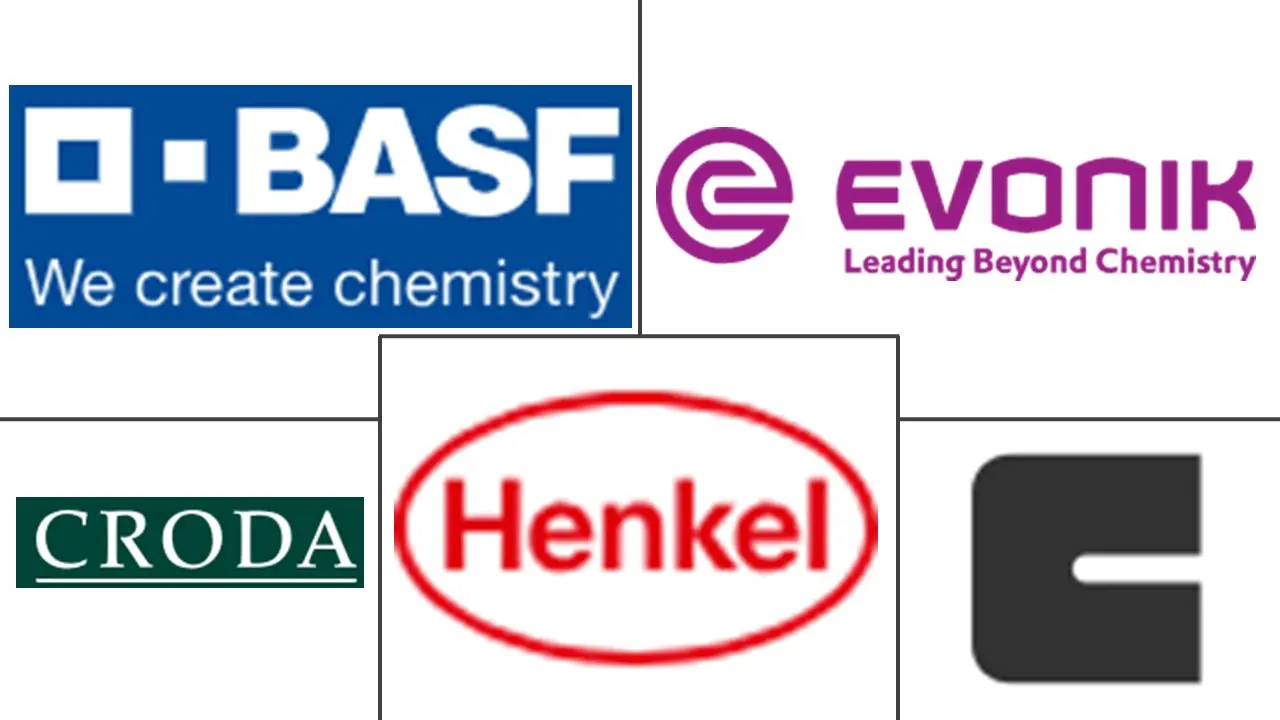Asia-Pacific Bio-Surfactants Market Size and Share
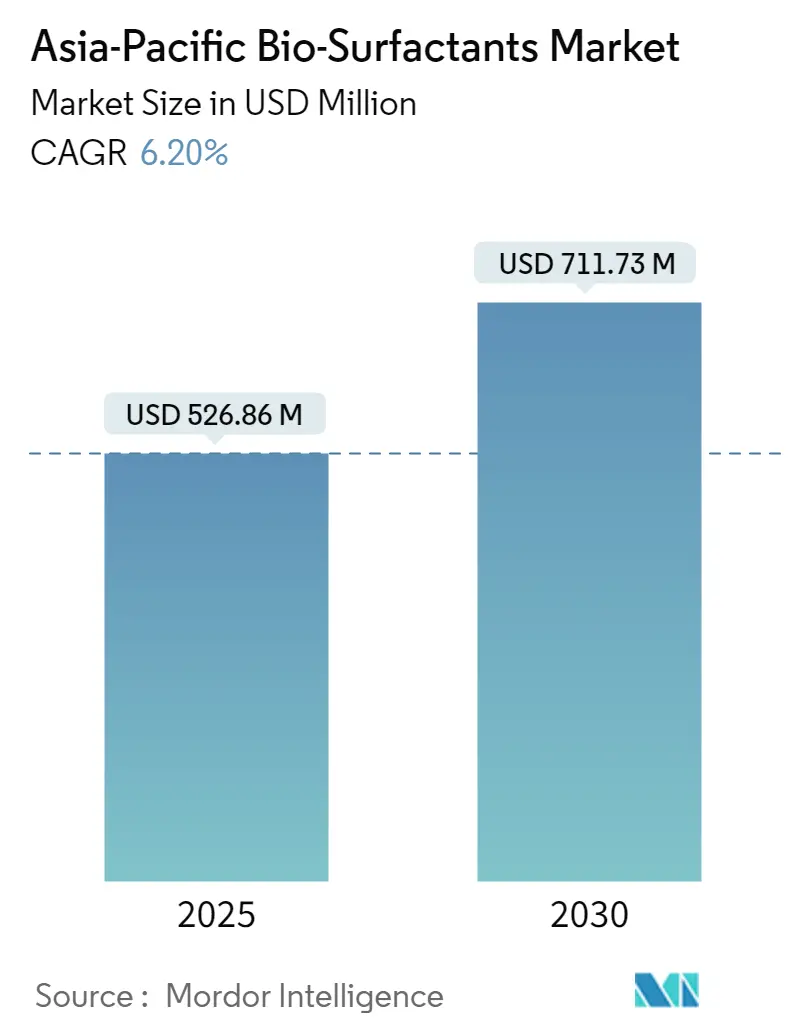
Asia-Pacific Bio-Surfactants Market Analysis by Mordor Intelligence
The Asia-Pacific Bio-Surfactants Market size is estimated at USD 526.86 million in 2025, and is expected to reach USD 711.73 million by 2030, at a CAGR of 6.2% during the forecast period (2025-2030).
The market was negatively impacted by the COVID-19 outbreak in 2020. However, the pandemic has further heightened consumers’ awareness of sustainability and health thus creating demand for innovative environment-friendly products and enhancing biosurfactants' market growth.
The increasing demand for cosmetics and personal care products, and the rising usage of bio-products are the major factors driving the growth of the market studied.
However, the higher production cost of bio-surfactants stands as a restraint for the growth of the studied market.
Growing innovation in the production methods of biosurfactants will optimize the overall cost of their products which is further expected to stage lucrative growth opportunities for the growth of the market studied.
China represents the largest market over the forecast period due to the rising demand from various industries, such as personal care, pharmaceuticals, agriculture, etc. in the region.
Asia-Pacific Bio-Surfactants Market Trends and Insights
Detergents and Industrial Cleaners Segment is Expected to Dominate the Market
- Surfactants are the active ingredients found in soaps and detergents with the ability to concentrate at the air-water interface. They are commonly used to separate oily materials from a particular media.
- Almost all surfactants, which are an important component used in modern-day commercial laundry detergents, are chemically synthesized and exert toxicity to freshwater living organisms.
- Growing public awareness about the environmental hazards and risks associated with chemical surfactants has stimulated the search for eco-friendly and natural substitutes for chemical surfactants in laundry detergents.
- Biosurfactants, such as Cyclic Lipopeptide (CLP), are stable across a wide pH range (7.0-12.0) and do not lose their surface-dynamic properties when heated to high temperatures. They demonstrate excellent emulsion creation capability with vegetable oils, as well as outstanding resemblance and strength to commercial clothes cleaners, indicating that they should be considered in a clothing cleaners strategy.
- According to the International Trade Centre, China exports the largest amount of Soap and organic surface-active products, with exported value reaching around USD 740.98 million.
- Hindustan Unilever's Surf Excel detergent brand is the first in India's home and personal care category to reach a billion dollars in annual sales in 2022.
- Surf detergent, which was launched six decades ago, now controls more than a fifth of India's total detergent market, which is worth INR 350 billion (~USD 4.45 billion).
- According to DCP (India), during the fiscal year 2022, over 780 thousand metric tons of synthetic detergent intermediates were produced across India.
- The positive trends and high export of detergents from countries like China contribute to the increasing demand for bio-surfactants in the Asia-Pacific region during the forecast period.
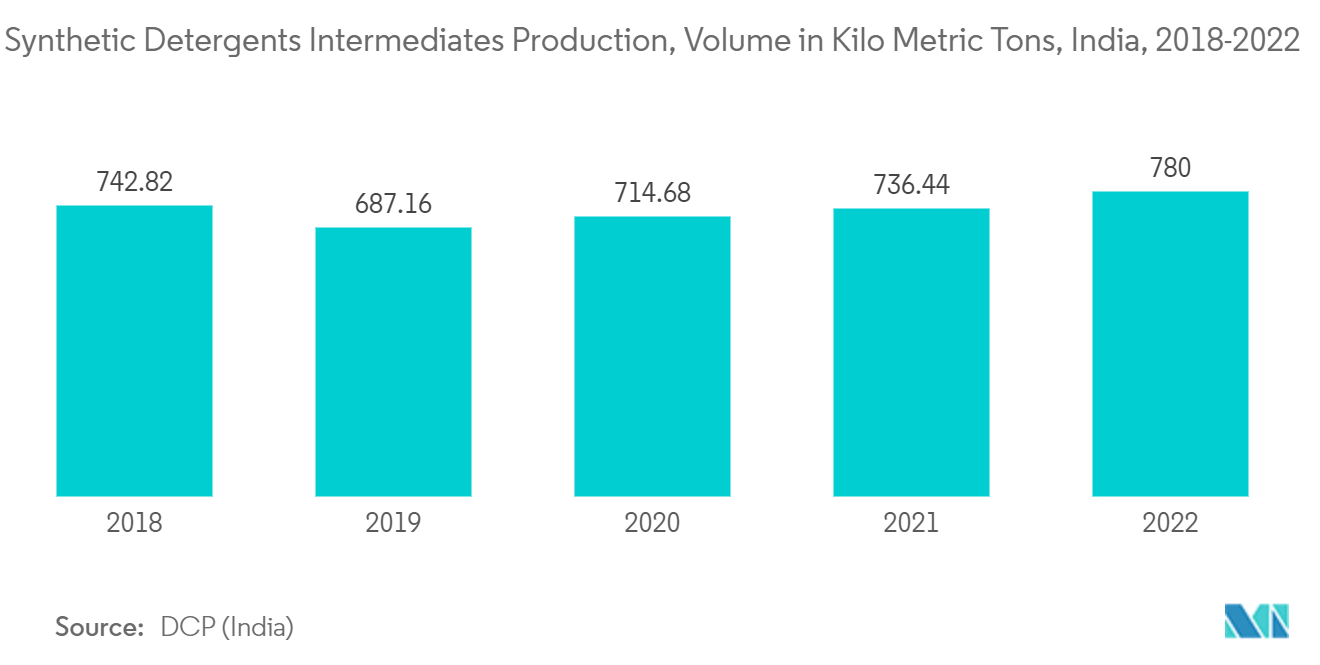
China to Dominate the Market
- Bio-surfactants are considered to be less toxic and eco-friendly. Thus, several types of biosurfactants have the potential to be commercially produced for extensive applications in cosmetics, agriculture, textile, and other industries.
- According to the National Bureau of Statistics of China, the retail sales of cosmetics by wholesale and retail companies in China totaled about CNY 393.6 billion (~USD 58.53 billion) in 2022.
- In agriculture, surfactants and adjuvants are additive chemicals spray products that are added to herbicides to enhance the activities of the spray combinations.
- In 2022, China exported over 1.3 million tons of herbicides, making it the largest type of pesticide exported from China in terms of volume.
- Additionally, according to the China National Garment Association, China produced around 23.24 billion pieces of clothes in 2022.
- In the food industry, bio-surfactants can be used for the cleaning and treatment of contact surfaces, acting as antimicrobial and anti-biofilm agents. They can also be incorporated directly into formulations as an additive or ingredient.
- Therefore, the strong demand from the domestic end-user industries is expected to continue stimulating the consumption of bio-surfactants in China over the forecast period.
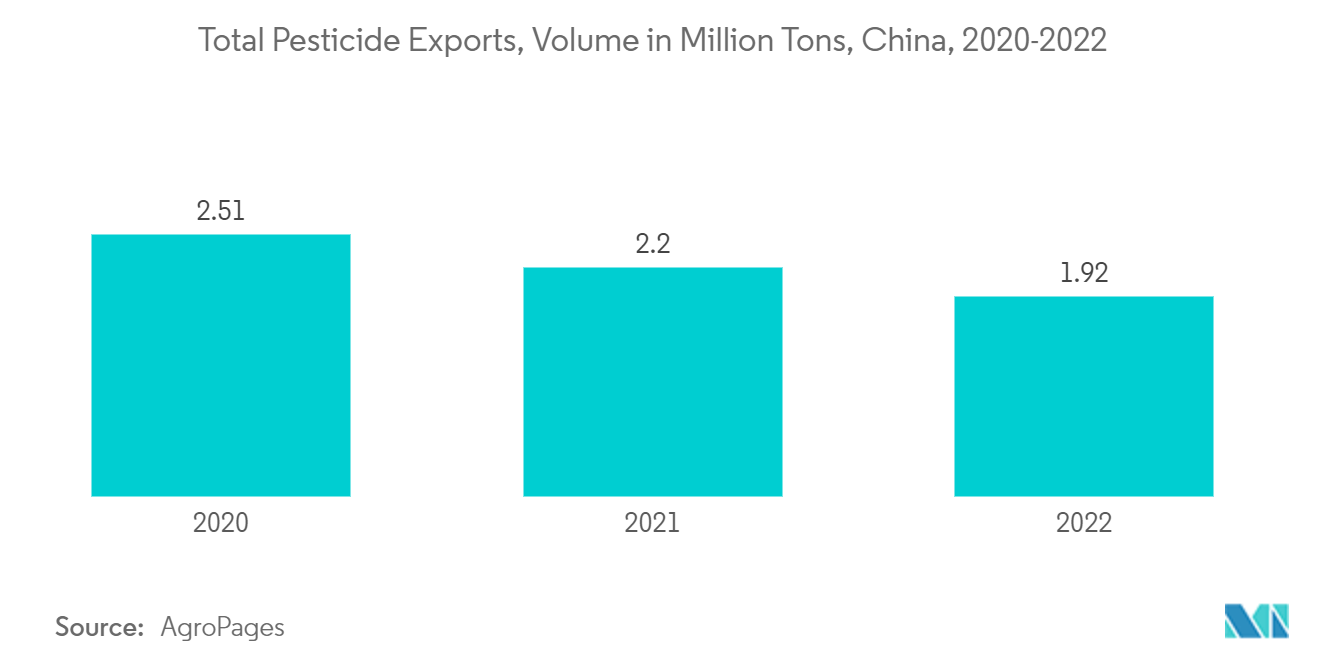
Competitive Landscape
The Asia-Pacific Bio-Surfactants Market is consolidated, with the top five players holding a significant share of market demand in the region. The major players (not in any particular order) include BASF SE, Henkel AG & Co. KGaA, Evonik Industries AG, Clariant, and Croda International Plc, among others.
Asia-Pacific Bio-Surfactants Industry Leaders
-
BASF SE
-
Henkel AG & Co. KGaA
-
Evonik Industries AG
-
Clariant
-
Croda International Plc
- *Disclaimer: Major Players sorted in no particular order
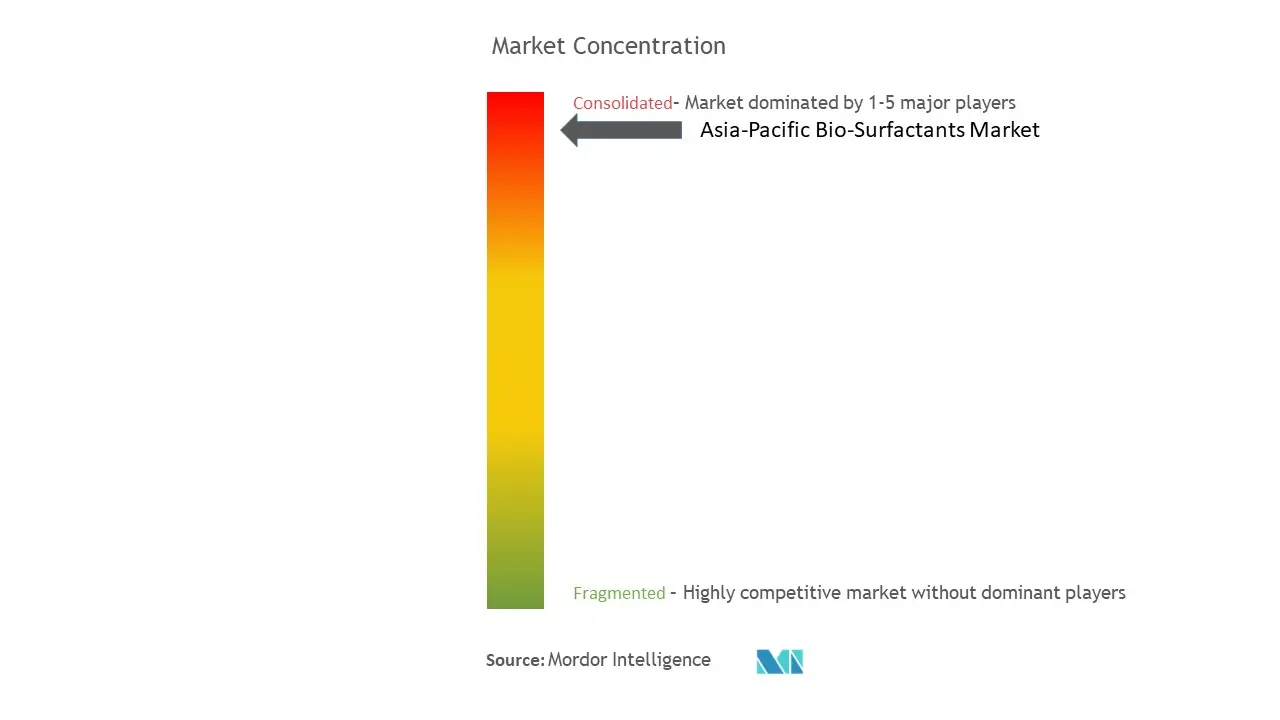
Recent Industry Developments
April 2022: BASF SE announced to expand its portfolio of sustainable cosmetics products with a bio-based surfactant made from soy protein. This expansion will help the company to have a strong grip on the Asia-Pacific market.
January 2022: Evonik Industries AG announced its plan to build the world's first industrial-scale production plant in Slovakia for rhamnolipids. This will enhance the company's product portfolio and strengthen its biosurfactant business in the Asia-Pacific region.
Asia-Pacific Bio-Surfactants Market Report Scope
Biosurfactants can be defined as surface-active biomolecules produced by microorganisms with a wide range of applications. Due to their unique properties like specificity, low toxicity, and relative ease of preparation, these surface-active biomolecules have attracted wide interest.
The biosurfactants market is segmented by product type, application, and geography. By product type, the market is segmented into glycolipids (rhamnolipids, trehalolipids, and sophorolipids), phospholipids, surfactin, lichenysin, polymeric, and other product types. By application, the market is segmented into detergents and industrial cleaners, cosmetics (personal care), food processing, oilfield chemicals, agricultural chemicals, textiles, and other applications. The report also covers the market size and forecasts for the biosurfactants market in 5 countries across the Asia-Pacific region. For each segment, the market sizing and forecasts have been done based on value (USD).
| Glycolipid (Rhamnolipids, Trehalolipids, and Sophorolipids) |
| Phospholipids |
| Surfactin |
| Lichenysin |
| Polymeric |
| Other Product Types |
| Detergents and Industrial Cleaners |
| Cosmetics (Personal Care) |
| Food Processing |
| Oilfield Chemicals |
| Agricultural Chemicals |
| Textiles |
| Other Applications |
| China |
| India |
| Japan |
| South Korea |
| ASEAN Countries |
| Rest of Asia-Pacific |
| Product Type | Glycolipid (Rhamnolipids, Trehalolipids, and Sophorolipids) |
| Phospholipids | |
| Surfactin | |
| Lichenysin | |
| Polymeric | |
| Other Product Types | |
| Application | Detergents and Industrial Cleaners |
| Cosmetics (Personal Care) | |
| Food Processing | |
| Oilfield Chemicals | |
| Agricultural Chemicals | |
| Textiles | |
| Other Applications | |
| Geography | China |
| India | |
| Japan | |
| South Korea | |
| ASEAN Countries | |
| Rest of Asia-Pacific |
Key Questions Answered in the Report
How big is the Asia-Pacific Bio-Surfactants Market?
The Asia-Pacific Bio-Surfactants Market size is expected to reach USD 526.86 million in 2025 and grow at a CAGR of 6.20% to reach USD 711.73 million by 2030.
What is the current Asia-Pacific Bio-Surfactants Market size?
In 2025, the Asia-Pacific Bio-Surfactants Market size is expected to reach USD 526.86 million.
Who are the key players in Asia-Pacific Bio-Surfactants Market?
BASF SE, Henkel AG & Co. KGaA, Evonik Industries AG, Clariant and Croda International Plc are the major companies operating in the Asia-Pacific Bio-Surfactants Market.
What years does this Asia-Pacific Bio-Surfactants Market cover, and what was the market size in 2024?
In 2024, the Asia-Pacific Bio-Surfactants Market size was estimated at USD 494.19 million. The report covers the Asia-Pacific Bio-Surfactants Market historical market size for years: 2019, 2020, 2021, 2022, 2023 and 2024. The report also forecasts the Asia-Pacific Bio-Surfactants Market size for years: 2025, 2026, 2027, 2028, 2029 and 2030.
Page last updated on:
Asia-Pacific Bio-Surfactants Market Report
Statistics for the 2025 Asia-Pacific Bio-Surfactants market share, size and revenue growth rate, created by Mordor Intelligence™ Industry Reports. Asia-Pacific Bio-Surfactants analysis includes a market forecast outlook for 2025 to 2030 and historical overview. Get a sample of this industry analysis as a free report PDF download.
